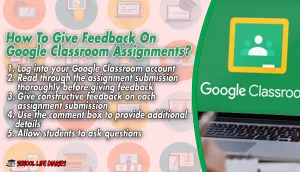The grading feature of Google Classroom allows teachers to assign grades to individual students’ work. This eliminates the need for paper-based assignments and assessments. Teachers can also create quizzes and exams which are automatically graded when the correct answer is selected.
Grading in Google Classroom doesn’t just make grading easier – it also saves time. It has a range of features that allow teachers to quickly get an overview of their student’s progress. For example, teachers can view the average grade for each student and analyze their performance in different subject areas.
Basic Concepts of Grading Methods in Google Classroom
Grading in Google Classroom is an important part of any institution. There are a variety of methods for teachers to use to evaluate student performance.
1. Individual Grading:
It allows teachers to assess each student’s work independently, while overall grading considers the entire class as a whole. Individual grading enables teachers to provide feedback specific to each student’s performance and encourages them to work hard to improve their results.
Ungraded Grading:
It is an assessment approach where a student’s performance on a specific task or assignment is not assigned a numerical score or letter grade but instead given qualitative feedback. Ungraded grading encourages students to focus on the learning process rather than striving for a perfect score.
Total Points:
Total points are the number of points assigned to an assignment or activity, based on its perceived difficulty or importance. It is important for instructors to assign point values that accurately reflect the amount of work needed to achieve high marks in a course, and total points can be used in combination with graded or ungraded assessments to evaluate student performance.
Rubrics:
A rubric is a tool used to measure and assess student learning outcomes, such as specific areas of mastery, in an organized and systematic way. Rubrics help instructors identify the strengths and weaknesses of each student’s work, while also providing guidance on what areas need improvement.
They can be used to evaluate graded or ungraded assignments, and are designed to provide a consistent evaluation of student performance. Rubrics also help ensure that grading is fair and equitable across the board, as all students receive feedback based on the same set of standards.
2. Overall Grading:
Overall grading provides an overview of the whole class’s performance and helps teachers identify trends in the classroom. Google Classroom has built-in tools for both individual grading and overall grading that make it easy for teachers to track student progress. Individual grading can be based on assignments or tests, while overall grading is based on ungraded activities such as participation and attendance.
No Overall Grade:
There is no overall grade given to a student at the semester or course’s end. Instead, individual assessment tasks such as tests and projects are graded individually, but there is no grade that encompasses all of a student’s work in the class. This can be beneficial for students who may not have done well in certain tasks but had strong overall performance throughout the course.
Total Points Grading:
This type of grading system assigns points to individual assessment tasks such as tests and projects, and these points are totaled up at the end of a particular semester or course. The total number of points earned by a student is then compared to the total points possible for that particular course.
This grading system helps to level the playing field among students who may not have scored highly on certain assessment tasks but had a strong performance in other areas.
Weighted by Category Grading:
This type of grading assigns weights to different categories of assessment tasks, such as tests and projects, so that students receive higher grades for tasks in which they have done particularly well. This allows students to be rewarded for excellence in certain areas while ensuring that they still get credit for their overall performance.
This is beneficial if certain courses or classes require a stronger emphasis on particular topics and assessment tasks. Weighted grading can help ensure that all students are fairly graded for the work they have done.
Is the Grading Method Compatible With Your Institution?
The traditional five-grade system of letter grades – A, B, C, D, and F – is widely used in educational institutions. Depending on the institution, there may be variations on this system that allow for awarding A+, A, & A−; B+, B, & B−; C+, C, & C−; D+, D, & D−, and F (E). These additional grades are meant to provide a more accurate assessment of academic performance than the traditional system is able to capture.
For example, an A+ grade may indicate that a student has gone above and beyond expectations while still meeting the requirements for an A grade. Conversely, a C- may reflect that a student has achieved the minimum requirements for their grade but hasn’t shown any excellence or mastery of the material.
| Letter Grade | Percentage | GPA (out off 4.0) |
| A | 90% – 100% | 4.0 |
| B | 80% – 89% | 3.0 |
| C | 70% – 79% | 2.0 |
| D | 60% – 69% | 1.0 |
| F | < 60% | 0.0 |
How To Set Up A Grading System In Google Classroom?
1. Go to classroom.google.com
2.Log in with your Google account credentials.
3. Once you’re logged in, click on the ‘+’ sign next to your class on the home page.
4. Go to the settings tab and select ‘Overall Grade Calculation’ from the left-hand menu.
5. In this section, you can configure how students’ final grades are calculated in your class. You can choose to calculate the overall grade based on total points or weighted by category. If you select ‘weighted by category’, you can also provide weights for each assignment type within the class.
6. When you’re finished configuring the overall grade calculation, click ‘Done’ and your settings will be saved.
How To Grade And Return An Assignment In Google Classroom?
1. Log in to your Google Classroom account and select the class for which you want to grade an assignment.
2. Select the assignment that needs to be graded.
3. Read through the assignment thoroughly and make notes of any key points or areas of improvement that need to be addressed.
4. Check all submitted assignments to ensure that all the requirements have been met.
5. Use rubrics to assess the work and provide meaningful feedback where necessary to help students understand their mistakes and improve their performance in future assignments.
6. Calculate each student’s grade for the assignment based on criteria set by you or as per your school’s grading policy.
7. Once you are satisfied with the grading process, save the grades in your Google Classroom account.
8. You can also create and assign grades for group projects by combining individual scores in the grade book.
9. Once all grades have been assigned, provide students with access to view their results and feedback.
How To View And Update Your Gradebook On Google Classroom?
1. Sign in to your Google Classroom account. You will need to have a valid Gmail account associated with the same Google Classroom account.
2. Click the “Classes” tab on the main page of your Google Classroom page, which will open up a list of all your classes.
3. Select the class you would like to access and click on the “Gradebook” tab in the top right-hand corner of that page.
4. Here you will be able to view the grade book for your class, where each student’s current average is displayed along with their assignments and test scores.
5. If you’d like to add a grade or update a score, click on the “+” icon located next to the student’s name and enter your desired grade. You can also edit existing grades by clicking on the pencil icon next to the current score.
6. Once all of your changes have been made, make sure to click the “Save” button at the top of the page so that your edits will be applied.
7. If you need to export your grade book into a different format, such as an Excel document or PDF file, you can do so by clicking on the “Export” tab located in the upper-right corner of the page.
How Do I Export Grades to Google Classroom?
Exporting grades from a classroom to Google Classroom is an efficient and easy way to help track student progress throughout the semester.
1. The first step for exporting grades to Google Classroom is to establish a connection between the grade book and the platform. To do this, the teacher must log into their Google Classroom account and select the “Settings” option. They must choose the “Integrations” tab and select the grade book program from the list of available integrations. Once selected, a verification code will be provided for authentication by the grade book program.
2.Log into the grade book program and enter the verification code that was previously generated. Once the verification code has been accepted, the grade book program and Google Classroom are connected.
3. Select which classes, assignments, and grades will be transferred from the grade book program to Google Classroom.
4. After selecting which data to transfer, generate a report in the grade book program for exporting the grades to Google Classroom.
5. The fifth step is to upload the report from the grade book program into Google Classroom.
Can Students Know the Grading System?
Yes, students can know the grading system. Schools usually tell students how grades are calculated and what scores they need to get for each grade. Most schools have their grading systems posted somewhere on their website or in the student handbook.
Some professors may provide a syllabus that outlines how grades will be calculated and what is expected of students to get each grade. It’s important for students to be aware of the grading system so they can plan accordingly and know what they need to do to get the grade they desire.
Where is the Grades Tab in Google Classroom?
In Google Classroom, the ‘Grades’ tab can be found in the left-hand side navigation panel. It is represented by an icon depicting a bar chart. By clicking on the ‘Grades’ tab, users can access their overall grade for the course and view each assignment’s score in more detail.
How to Customize Grading According to Your Class?
Customizing the grading process can be a great way to ensure that each student in your class is getting the individualized attention they need. By creating unique grading criteria and expectations, you can tailor the learning experience to best meet the needs of your students. Here are some tips for how to customize grading according to your particular class:
1. Assess student learning objectives:
Before customizing the grading process, it is important to have a clear understanding of each student’s individual goals and objectives. Taking the time to assess what each student wants to gain from the course will help you create an appropriate system for grading their progress.
2. Develop flexible criteria:
A one-size-fits-all approach to grading does not work for every student. Developing flexible criteria that take into account individual skills, interests, and learning styles can help make the process more meaningful to each student’s style of learning.
3. Provide feedback:
Grading should be used as an informative tool that helps guide students in their learning process. Providing meaningful feedback that is based on the individual student’s progress can help them make more informed decisions as they move forward with their studies.
4. Utilize technology:
Technology can be a great asset when it comes to customizing the grading process. There are many different software and apps that can help organize student work, make grading easier, and provide feedback more quickly.
How To Grade With a Rubric in Google Classroom?
1. Understand the rubric:
Before beginning to grade with a rubric in Google Classroom, it is important to make sure that you understand how the rubric works. Read through each assessment category and ensure that you are familiar with what is expected from students. Consider asking questions to your students or colleagues if you have any queries about the rubric.
2. Use the rubric to grade:
Once you are familiar with the rubric, begin using it to grade student work. When grading a student’s assignment, assess each of their answers according to the criteria outlined in the rubric, and assign them a score accordingly. Be sure to provide feedback, as this will help students to improve their work.
3. Make rubric modifications:
If you find that your rubric doesn’t quite fit the assignment, make modifications as necessary. You can also add additional categories or criteria, in addition, to better assess each piece of a student’s work. Remember to communicate any changes you make to both yourself and the students.
4. Provide detailed feedback:
Provide students with detailed feedback on their work using the rubric as a guide. It is important to comment on what they did well and what areas they need to improve upon in order for them to succeed in the future. By doing this, you will help them to understand how their work was graded and how they can improve it.
Related Article: A Complete Guide to Setting Up Google Classroom For Parents
How To Give Feedback on Google Classroom Assignments?
1. Log into your Google Classroom account:
It is easy to access from the main Google page where you can sign in with your credentials. Once logged in, you will have access to all of your class assignments and be able to view student submissions for each assignment.
2. Read through the assignment submission thoroughly before giving feedback:
It is important to consider the student’s effort, their answers to questions posed, and any other evidence that they provide. Look for anything that merits recognition or areas in which improvement could be made.
3. Give constructive feedback on each assignment submission:
Make sure to give clear, specific directions on how the student can improve their work or continue to excel. Encouraging language and highlighting areas of success can help build a student’s confidence.
4. Use the comment box to provide additional details:
If there are mistakes that need to be corrected, using the comment box is an effective way to quickly point out any errors without having to type out an entire explanation.
5. Allow students to ask questions:
If they need clarification on any of the feedback you have provided. This encourages them to engage with their work and thinks more critically about what is expected of them.
Final Thoughts:
Grading in Google Classroom is a quick and easy way to keep track of your student’s progress. By using the features that Google Classroom offers, you can make sure that every student is on track and receiving the grades they deserve. Grading in Google Classroom can save time for teachers while also providing valuable data to students about their progress. If you are a student or teacher, who is looking for an efficient way to grade assignments and track progress, Google Classroom may be the right solution for you.






